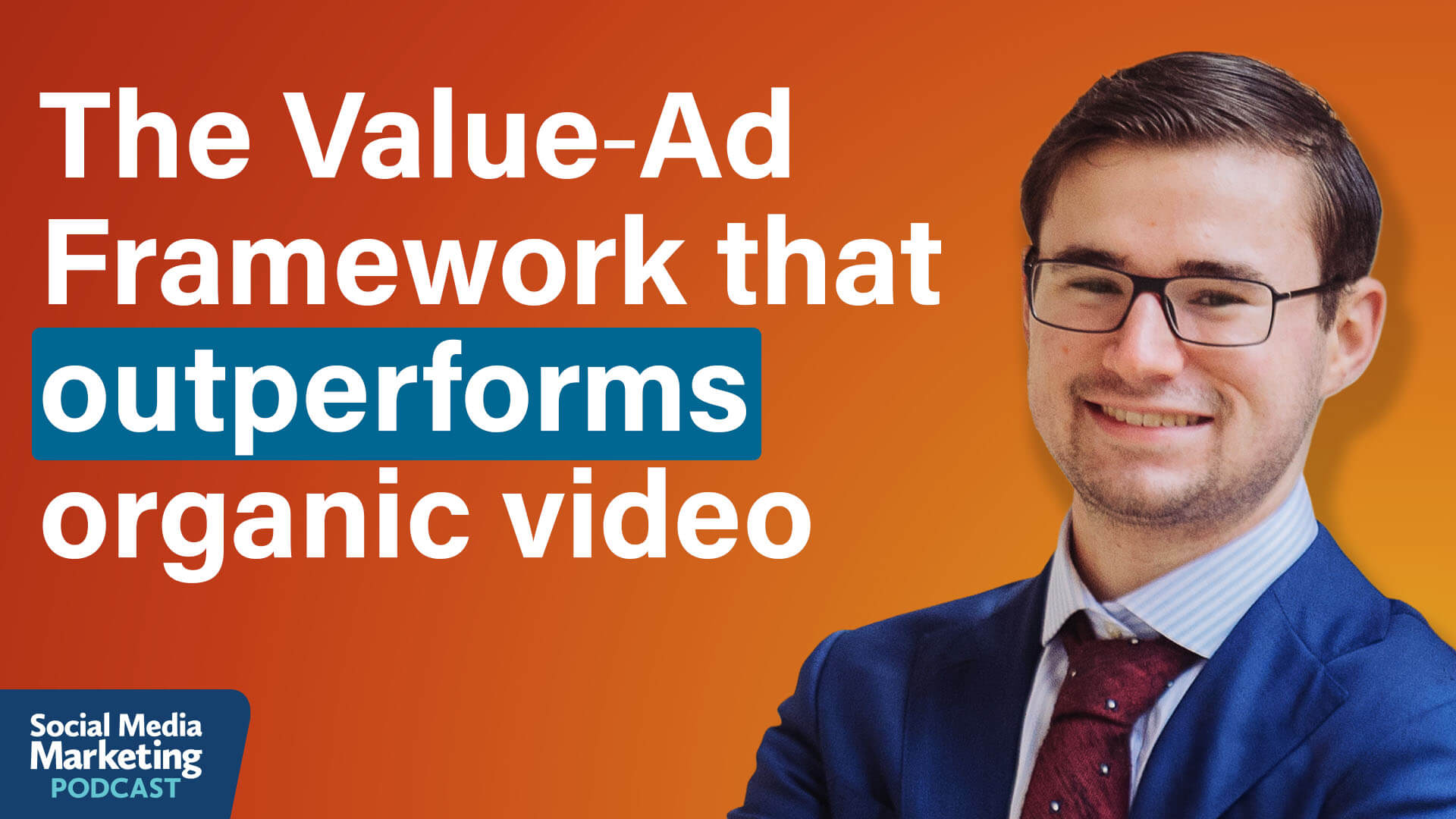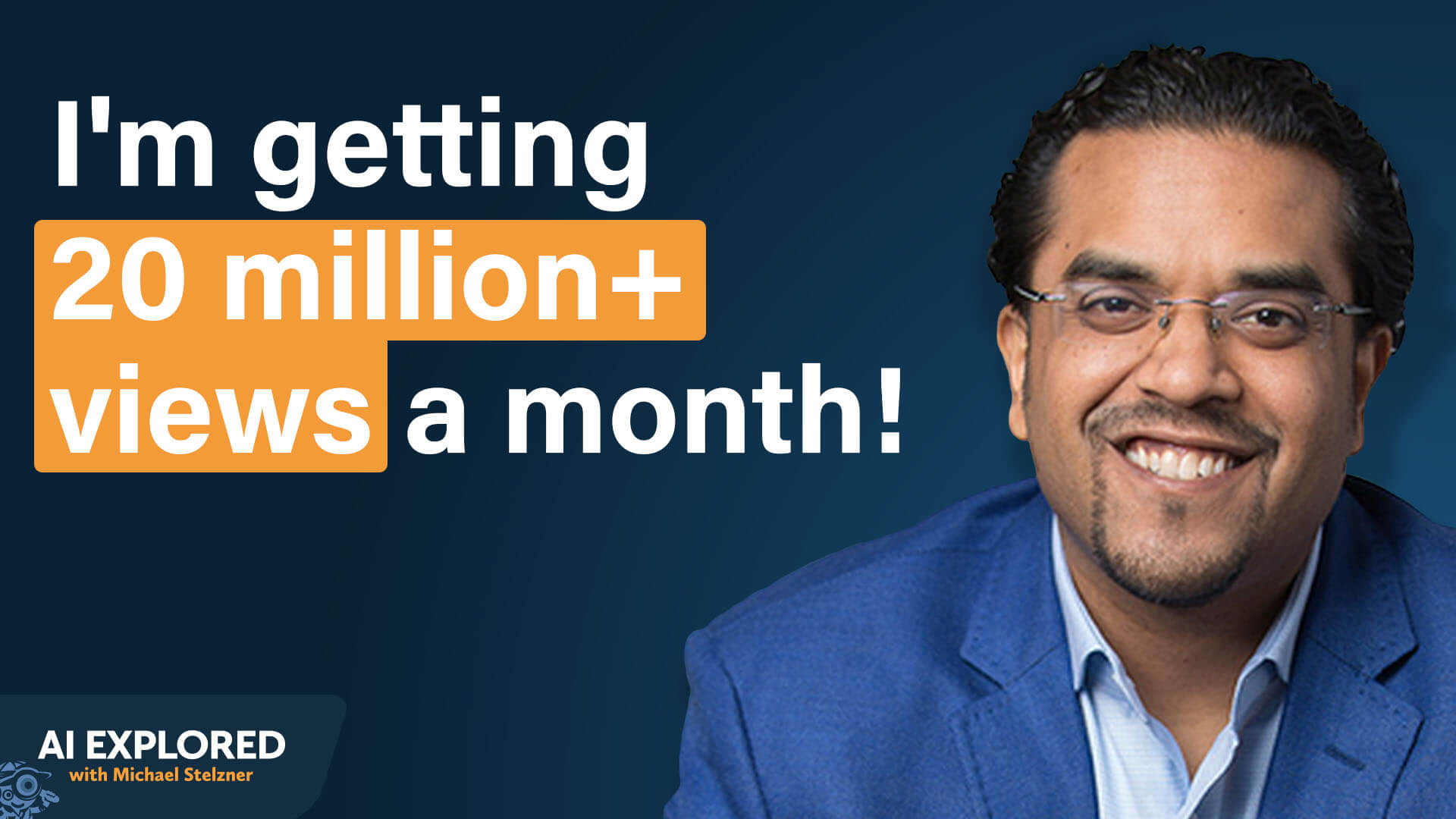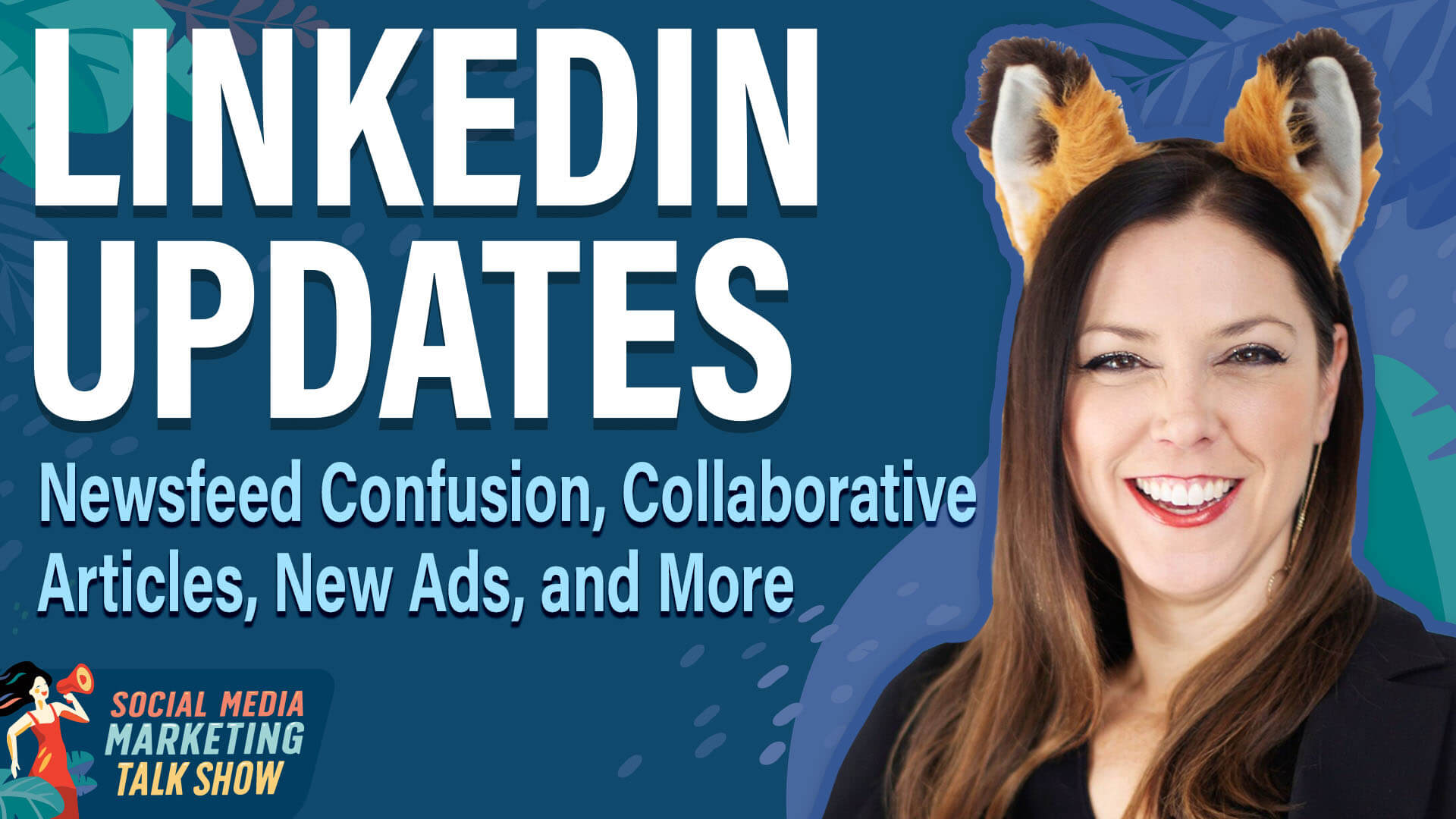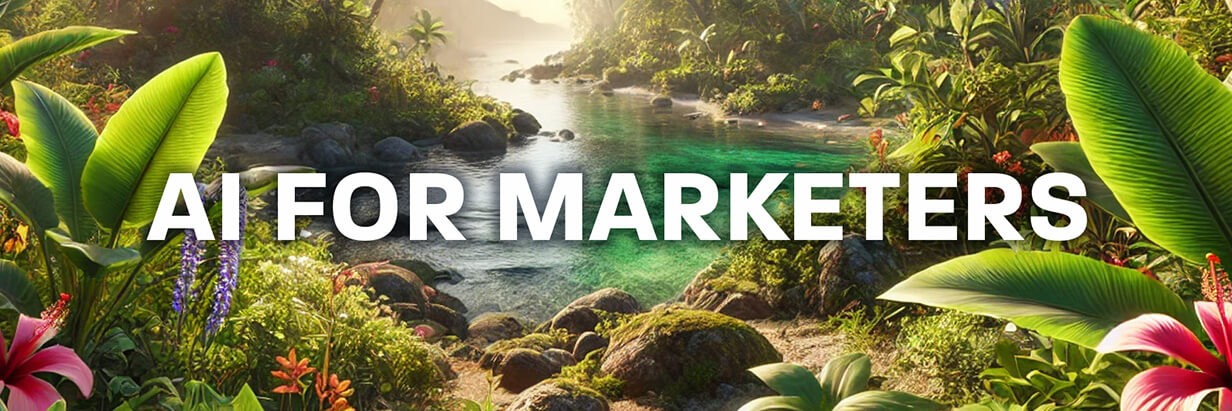Today's Guide to the Marketing Jungle from Social Media Examiner...
presented by 
The weekend is almost here, Pz! Here's a recap of the most important insights, trends, and updates from the week. Catch up in minutes and go into next week prepared.
In today's edition:
-
Instagram DM strategy for growing your email list
-
Your captions might be hurting your video engagement
-
How Meta Andromeda impacts your ad strategy
-
The 3-part Value Ad Framework for video
-
Growing your social reach with scalable video
-
LinkedIn Updates: Newsfeed Confusion, Collaborative Articles, New Ads, and More
-
16 ways to disclose AI content
-
What to know about using AI on LinkedIn
-
🗞️ Industry news from Anthropic, LinkedIn, Meta, and more

How to Set Up Instagram DMs for Email Capture
What if you could grow your email list, nurture leads, and drive sales without leaving Instagram?
In this deep-dive conversation, Elizabeth Marberry talks with DM automation expert Heston Roberts about how to cut through Instagram's friction-filled UX to boost your conversion rates with fewer dead-end convos.
You'll also hear practical examples of how smart marketers are collecting emails, increasing visibility, and making their content go further—without burnout or spammy tactics. Hear more here.
Video Caption Strategy
85% of video viewers watch with the sound off, so your captions aren't optional—they're strategic tools.
But, if they're used incorrectly, they can tank your performance just as easily as they can boost it.
This breakdown from Brendan Kane goes beyond the obvious. It reveals when not to use captions, how to craft them to spark curiosity, and subtle placement tricks that drive millions of views. Think caption color, timing, and positioning all adjusted for silent scrollers and sound-off swipers.
If you're already creating short-form video for Instagram, TikTok, or LinkedIn and wondering why the algorithm isn't rewarding you, the right caption strategy might be the growth lever you've been missing. Read more here.
Meta Just Changed How Ads Work. Are You Ready for It?
You've probably seen Meta's new term making the rounds: Andromeda. This AI-powered system is already reshaping how your ads are delivered.
Meta isn't just tweaking targeting options or rolling out another feature. Andromeda marks a deeper shift, from tight demographic targeting to creative-driven personalization at scale. In simple terms: your creative strategy is now your targeting strategy.
But what does that actually mean for your workflow? Should you start producing 50 versions of every ad? And does this system really boost performance?
Jon Loomer skips the hardware jargon and dives straight into what marketers actually need to know.
If you're navigating ad creation, campaign setup, or wondering how to future-proof your Meta strategy without losing time (or your mind), this is the update to pay attention to. Read more here.

What's YOUR AI Readiness Level, Pz?
Marketing is changing faster than ever before because of AI. Are you keeping up? Our free 3-minute assessment reveals your exact AI readiness level and provides you with a personalized 30-day action plan to accelerate your growth.
In just a few questions, you'll discover:
🔥 Your current AI readiness level
🔥 The advantages and challenges of where you are today
🔥 A personalized 30-day action plan
🔥 Ways to level up fast
Stop guessing what to learn next and get a clear path forward, tailored just for you.
Take my free assessment.

Educational Video Ads: The Secret to More Leads and Sales
Most people think of video ads as fifteen or thirty-second spots that aren't really providing a whole lot of value.
But the proven Value Ad Framework flips that on its head to create an ad that's designed to feel native to the platform and provide genuine value, while also driving people off the platform to convert in your funnels.
This approach combines the best of both content marketing and direct response advertising. You're providing real value inside the ad itself, giving viewers aha moments and demonstrating your expertise, but you're also including clear calls to action that drive people to take the next step with your business.
The Value Ad framework consists of three essential components. Each component serves a specific purpose in moving viewers from initial interest to taking action.
The Value Ad Framework Educate Section
The education section represents the heart of your ad, where you transition from capturing attention to building genuine trust and credibility with your audience. This is where you provide real, genuine value, educate your viewers, and actually teach them something meaningful about your area of expertise.
The specific approach you take in your education section depends largely on the type of business you're running and what you're ultimately trying to sell.
If you're running an expert-based business, such as coaching, consulting, or selling information products, your approach is relatively straightforward. You are an expert, or your company has an expert spokesperson, and you want to lead with some of the biggest aha moments that your ideal clients typically have.
The goal is to present those aha moments in a way that demonstrates your expertise while providing immediately actionable insights. You want your viewers to think, "Wow, I never thought about it that way" or "That makes so much sense now." These moments of clarity create the trust and credibility necessary for viewers to want to learn more from you.
If you're selling a physical product, software, or service, your educate section should demonstrate that product or service solving problems in ways that are superior to alternatives. You want to showcase your unique advantage or competitive advantage that will be most appealing to your ideal clients.
For physical products, this might involve showing the product in action, highlighting unique features, or demonstrating superior performance compared to what's currently available. For services, you might showcase your process, typical results, or the unique methodology that sets you apart from competitors.
The key is making sure your demonstration directly connects to the problem or desire you highlighted in your hook, showing viewers exactly how your solution addresses their specific needs.
Software companies have a particular advantage in the education section because they can provide mini-demos that show exactly how their solution works in real time. If you have software that tracks data better than alternatives, analyzes information more effectively, or automates processes that currently require manual work, you can demonstrate these capabilities directly.
The most effective software demonstrations show a before-and-after comparison, illustrating the manual, time-consuming way people currently handle a task, then showing how your software accomplishes the same result in a fraction of the time with better accuracy.
Other topics discussed include:
-
5 Value Ad Hook Tactics and Examples
-
4 Value Ad Education Section Examples
-
Strategic Timing for Product Reveals
-
The Value Ad Call to Action: Lead Generation vs. Direct Sales Strategy
-
Using Google Veo 3 to Create Video Ad Hooks
Today's advice is provided with insights from Aleric Heck, a featured guest on the Social Media Marketing Podcast.
Watch the full interview on YouTube
AI Social Video at Scale: Grow Your Reach, Regain Your Time
One of the biggest barriers to AI-assisted content creation isn't technical but psychological. Many creators worry that audiences will reject AI-generated content or view it as low-effort deception.
Singal experienced this concern intensely. This fear held him back until business pressures forced a thirty-day experiment. The results contradicted his assumptions entirely. People messaging him said things like, "Man, I love that video. It was really helpful. I know it's AI, but it's awesome."
Rather than hiding AI usage, Singal made transparency central to his brand. In long-form videos, a quote appears: "Hey, this is AI Anik. While the real Anik's out building his empire, building great businesses, I'm here to represent him and teach you about ..."
Short-form content descriptions include statements like "AI Anik on the hunt again today, reporting with ..." This clear disclosure eliminates deception while positioning AI as a sophisticated business tool rather than a shortcut.
The transparency approach transformed potential criticism into competitive advantage. Webinar attendees now joke, "Is this really you, or is it AI Anik?" When he confirms it's really him, they playfully request to see AI Anik instead.
Tools for AI Video Content Creation: ElevenLabs and HeyGen
Video content requires more technical sophistication than written content, but the results can be dramatically more engaging and scalable. Singal's approach combines two primary tools to create what he calls "AI Anik" - his AI avatar.
ElevenLabs currently provides the highest quality AI voice generation, though other tools are beginning to approach its capabilities. Most outputs are ninety-five percent perfect, requiring only minor adjustments to a few words or sounds. When problems occur, edit the script and regenerate the affected sections.
The key to success lies in proper training and script preparation.
Training your voice model requires approximately three hours of audio recorded in the same location with the same microphone and acoustics. The audio doesn't need to be scripted—podcast recordings work perfectly well as long as they meet the consistency requirements.
Scripts require specific formatting before generating audio to avoid common ElevenLabs issues.
You'll need to remove all punctuation except commas and periods. Dashes, ellipses, semicolons, and other punctuation marks cause the system to insert random sounds or create awkward pauses. You can automate this process by asking AI to reformat scripts: "Can you just give me the script again and remove all punctuation except for commas and periods?" This simple step eliminates most audio generation problems.
Proper names and unusual words can also cause issues. Singal's first name, Anik, gets mispronounced consistently, requiring phonetic respelling to achieve correct pronunciation. When faced with pronunciation problems, the simplest solution is often to replace problematic words with alternatives that convey the same meaning.
HeyGen provides the video component of AI avatar creation, but success requires understanding the platform's limitations and optimizing your training footage accordingly. Singal's team discovered that ignoring HeyGen's official instructions and developing their own approach produced superior results.
Effective HeyGen training requires specific recording conditions that differ from typical video production. Use close-up camera angles that eliminate arm and hand movements from the frame. Position the camera so viewers see from a few inches below the shoulders upward.
Additionally, lighting quality dramatically impacts results, creating training data the AI cannot effectively process and leading to subpar video output. Invest in professional lighting equipment or hire someone with proper lighting knowledge.
During training footage, minimize hand gestures, head movements, eye squints, and other dynamic expressions because the AI learns these movements but applies them inappropriately in generated content. While you shouldn't appear robotic, reducing movement gives the AI fewer variables to manage incorrectly.
Once both voice training and video training are complete, the content creation process becomes straightforward. Upload your ElevenLabs audio file to HeyGen, select your preferred scene, and generate the video.
Most outputs are immediately usable, though occasionally you may need to regenerate if the lip-sync or other elements aren't satisfactory. The regeneration process typically resolves any issues quickly.
Pro Tip: You can create multiple "scenes" in HeyGen by recording in different clothing and settings. This provides variety for ongoing content creation and prevents the awkward appearance of wearing identical clothes in every video posted over time. The more scenes you provide, the better the AI understands your appearance and mannerisms. Singal recommends creating five to ten different scenes with various clothing options and potentially different locations.
Other topics discussed include:
-
Choose From 3 Social Media Identity Paths
-
Apply The 10X Rule for Strategic Topic Selection
-
Tools for AI-Powered Writing: Claude and Poppy
-
How to Ensure Quality Control of Your AI-Written Content
-
Video Editing With SubMagic
-
Implementation Strategy: Building Your AI Social Content Creation System
Today's advice provided with insights from Anik Singal, a featured guest on the AI Explored podcast.
Watch the full interview on YouTube
On this week's Social Media Marketing Talk Show, host Jerry Potter and Judi Fox break down the latest LinkedIn news and what it means for marketers like you.
Collaborative Articles Feature Retired
LinkedIn has officially retired its collaborative articles feature, ending the ability for users to contribute to these industry-focused discussion threads. As of mid-August, users can no longer add, edit, or contribute new content to existing collaborative articles, though the existing content remains accessible for reading and can still appear in search results.
While the feature is no longer accepting new contributions, the existing content represents a valuable resource for content creators looking to repurpose their previous contributions.
LinkedIn strategist Judy Fox recommends that users review their past collaborative article contributions and transform their best responses into standalone posts.
The strategic value of this repurposing approach lies in the original design of collaborative articles, which were structured to elicit expert-level responses to common industry questions. These responses were crafted to demonstrate thought leadership and industry expertise, making them ideal candidates for transformation into educational content.
For businesses whose team members or executives contributed to collaborative articles, this represents an opportunity to extract valuable thought leadership content and present it in new formats. C-suite executives who provided insights on collaborative articles can see those contributions developed into comprehensive posts that showcase their expertise to broader audiences.
The process of repurposing this content involves more than simply copying and pasting previous responses. The most effective approach involves expanding on the original insights, adding current examples or case studies, and structuring the content to stand alone as valuable educational material.
The positioning strategy that made collaborative articles effective—answering questions in ways that demonstrate expertise—remains relevant for current LinkedIn content creation. The question-and-answer format naturally positions the author as knowledgeable and helpful, which aligns with LinkedIn's algorithm objective of helping users learn within their professional domains.
Since the existing collaborative articles remain accessible and searchable, users can still link to their contributions within new posts, creating a bridge between their historical thought leadership and current content strategy. This approach allows content creators to reference their past expertise while developing new perspectives on the same topics.
Thought Leader Event Ads Launch Globally
LinkedIn has introduced thought leader event ads, a new advertising format that combines the trust and authenticity of individual thought leaders with the promotional power of paid advertising. This feature is now available globally within Campaign Manager and represents LinkedIn's response to B2B marketers' increasing demand for authentic, trust-based advertising approaches.
The feature allows businesses to sponsor posts from individual thought leaders or C-suite executives that promote LinkedIn events. Rather than running corporate ads that may feel impersonal, companies can amplify posts from recognized industry experts, essentially borrowing their credibility and established audience relationships.
The psychological principle behind thought leader event ads recognizes that people trust individual humans more readily than they trust corporate brands, especially when it comes to attending events or consuming educational content. When a respected industry expert personally invites their network to an event, it carries significantly more weight than a generic corporate advertisement.
The process requires approval from the thought leader before any promotional campaign can begin, ensuring that individuals maintain control over how their personal brand is used in advertising. This approval mechanism protects both the thought leader's reputation and the advertiser's investment by ensuring authentic alignment between the spokesperson and the promoted content.
For businesses, this advertising format opens new possibilities for event promotion, webinar marketing, and educational content distribution. Companies can identify respected voices in their industry and collaborate with them to create authentic promotional content that reaches broader audiences through paid amplification.
The format works particularly well for promoting off-platform events, whether they're hosted on Zoom, conducted in person, or managed through other event platforms. The combination of personal endorsement and paid reach can significantly increase event attendance and engagement compared to traditional corporate advertising approaches.
From a strategic perspective, thought leader event ads require businesses to think more collaboratively about their marketing efforts. Instead of solely focusing on promoting their own brand voices, successful implementation requires identifying and building relationships with industry thought leaders who can authentically represent their events and educational content.
More Features, Tools, Changes, and Updates Discussed Include:
Watch it on YouTube
16 Ways to Disclose Content Generated or Enhanced by AI
Worried a Written with AI tag will make your content less trustworthy? With the right framing, that disclaimer can actually boost your credibility.
As marketers increasingly turn to AI to brainstorm, draft, or polish content, the next challenge isn't just using the tools; it's owning the collaboration. Today's audience isn't anti-AI; they just want transparency and a human touch. So how do you signal both without sounding robotic or apologetic?
Angie Carel shares several relatable ways to disclose AI's role in your creative process without undermining your expertise. From subtle byline tweaks to confident post openers, these real-world examples strike the balance between tech-savvy and human-led.
Whether you're drafting LinkedIn thought leadership, Instagram carousels, or email newsletters, these ideas help you stay authentic and on-brand. Read more here.
Safely Using AI Tools on LinkedIn
AI promises speed, scale, and smarter strategies, but on LinkedIn, it can also get your account banned.
In this episode, Michelle J Raymond dives into the fine line between helpful automation and brand-damaging shortcuts.
Before recommending a platform or scheduling that next campaign, you'll want to hear what Michelle learned from a high-profile tool shutdown and why even legit-looking software can backfire. She unpacks what LinkedIn allows (and what it doesn't), why engagement pods and auto-DMs are red flags, and which tools can boost your productivity—without risking your brand. Watch more here.

Facebook to Deprecate Metrics in API: Meta will deprecate the impressions and page fans metrics from the Page Insights API starting November 15, 2025, replacing impressions with views to align with insights in the Facebook app and Meta Business Suite. This move follows the full deprecation of classic Facebook Pages and their Insights tab. Developers have a 90-day notice to adapt integrations before API calls for these metrics begin returning errors. Meta
Facebook Updates Professional Dashboard on Web with New Insights: Facebook has refreshed its Professional Dashboard on the web to better support creators with a new home screen, simplified navigation, and improved cross-platform consistency. The update brings key performance insights like earnings and engagement front and center, while tools like Comments Manager now mirror the mobile experience. New metrics—including views over time, view rate, and retention—help creators refine their content strategy. Additional features like data exports and bulk uploads are expected soon. Meta
New Tools for Smoother Edits and Better Reels Placement: The Edits app has rolled out several updates aimed at enhancing video creation and performance analysis. iOS users can now animate with greater precision using keyframe curves, while new safe zones ensure text and elements aren't hidden by interface overlays on Reels. Additional updates include the ability to swipe between Reels in the Insights tab for easier engagement comparison, a Snap to Edge tool for better content alignment, and a detailed export progress view for more transparent rendering feedback. Instagram
LinkedIn Adds Notifications for Profile Views and Followers from Posts: LinkedIn has introduced new notifications that alert users when posts generate profile views, new followers, and impressions. These alerts are sent at three- and seven-day intervals, allowing members to track both short- and long-term post performance. Building on LinkedIn's earlier analytics refresh, the update emphasizes meaningful engagement metrics that signal lead generation and networking potential. By surfacing these insights directly in notifications, LinkedIn gives users a clearer view of how their content drives professional connections and growth. Search Engine Journal
TikTok Strengthens Community Guidelines with Clearer Rules and AI Enforcement: TikTok has introduced an updated version of its Community Guidelines, featuring simpler language and new or revised policies addressing misinformation, bullying, and regulated goods. The platform has also expanded guidance for account features such as direct messaging, comments, LIVE, and TikTok Shop, alongside greater transparency on regional enforcement and emerging harms. To ensure consistent application, TikTok is enhancing moderator training and expanding AI-driven moderation, which already removes the majority of policy-violating content proactively. The updated rules will take effect on September 13, 2025. TikTok
TikTok Tests Five-Hashtag Limit on Posts: TikTok is experimenting with a five-hashtag limit on posts for some users, following a broader industry trend of reducing reliance on hashtags. While TikTok has not provided an official explanation, reports suggest the move aims to streamline the viewing experience and reduce clutter in the feed. Marketers and creators may need to rely more on TikTok's Trends dashboard to identify the most impactful hashtags for reach and engagement. Social Media Today
Claude Code Joins Enterprise Plans with New Admin and Compliance Tools: Anthropic has expanded its Enterprise and Team plans by bundling Claude Code with premium seats, enabling developers to move seamlessly between ideation in Claude and implementation in the coding agent. Admins gain enhanced control through self-serve seat management, granular spend limits, and detailed usage analytics. A new Compliance API also provides real-time access to usage data and customer content, helping organizations meet regulatory and auditing needs while scaling AI adoption. Anthropic
Instagram Launches Reels Series Linking for Better Storytelling: Instagram has rolled out a new feature that lets creators link multiple Reels into a series, enabling viewers to easily follow along without searching for the next part. Available via the captioning interface or the overflow menu on existing posts, the feature introduces a new navigation button on the bottom left of each Reel for seamless progression through related videos. Instagram says the update was highly requested and aims to enrich storytelling while increasing engagement and watch time. The feature is ideal for creators producing serial content or themed collections, such as tutorials or seasonal projects. TechCrunch
LinkedIn Limits on Excessive Commenting: LinkedIn has implemented new restrictions to curb spam and maintain a professional environment by limiting how many comments a user or Page can post within a set timeframe. Additionally, if the platform detects abnormal commenting behavior or signs of automation, it may reduce the visibility of those comments. These updates aim to protect user experience by encouraging genuine interactions and discouraging automated or excessive engagement tactics. LinkedIn
Meta Unwraps AI Holiday Tools for Smarter Ads: Meta is equipping marketers with a suite of AI-driven tools to boost performance and efficiency during the holiday season. The new creator commerce updates make it easier to discover regional and language-aligned influencers, while enabling creator content to be dynamically integrated into catalog ads featuring testimonial-style endorsements. Upgraded Reels formats now let brands turn single media into shoppable assets, showcase product carousels, and highlight product details. AI-powered flexible media automatically adapts creative across placements, delivering a 23% lift in conversions. Globally available ad formats now optimize for both online and in-store purchases. Meta
Meta Expands AI Translation Tools for Reels on Facebook and Instagram: Meta is rolling out AI-powered translations for reels, enabling automatic dubbing and lip syncing in creators' own voices. The tool, available first for English-to-Spanish and Spanish-to-English, allows Facebook creators with 1,000 or more followers and all Instagram public accounts to make their content more accessible to global audiences. Creators can review translations, track views by language, and maintain full control over how translations appear. In addition, Facebook Page owners can upload up to 20 of their own dubbed audio tracks per reel, offering a powerful way to engage multilingual audiences. Meta
YouTube Rolls Out New Tools for Moderation, Effects, and Brand Deals: YouTube is introducing several updates to support creators, including bulk comment moderation in Studio and a new subscriber-only comments option to improve community engagement. The platform is also expanding Effect Maker, a desktop tool for building and publishing Shorts effects, with plans to add generative AI-powered tools later this year. Additionally, BrandConnect now allows creators to tag brand partners on individual videos, giving advertisers more control over campaign content and access to organic performance data. YouTube
What Did You Think of Today's Newsletter?
Did You Know?
Sylvester the Cat's name is a pun on "Felis silvestris," which is the scientific name for the wildcat species.

Michael Stelzner, Founder and CEO
P.S. Add
michael@socialmediaexaminer.com into your contacts list. Use Gmail?
Go here to add us as a contact.
We publish updates with links for our new posts and content from partners. Your information: Email:
punjabsvera@gmail.com Opted in on: 2022-03-22 16:02:45 UTC.